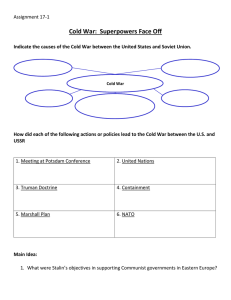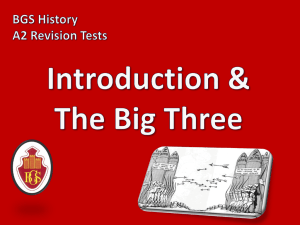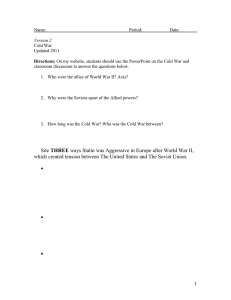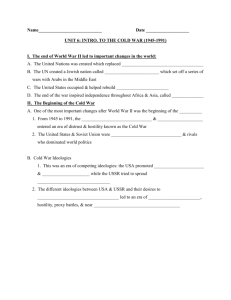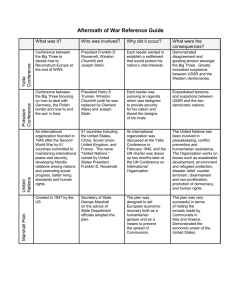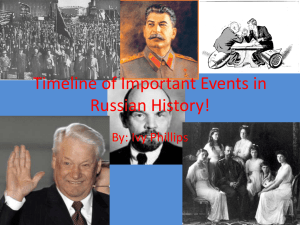CC KQ5 Who was to blame for the Cold War
advertisement
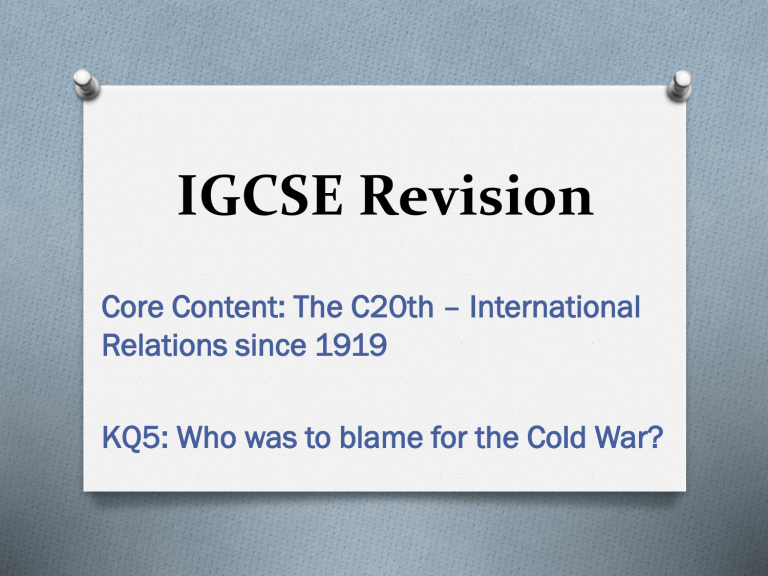
IGCSE Revision Core Content: The C20th – International Relations since 1919 KQ5: Who was to blame for the Cold War? Core Content KQ5: Who was to blame for the Cold War? Focus: • Why did the USA-USSR alliance begin to break down in 1945? • How had the USSR gained control of Eastern Europe by 1948? • How did the USA react to Soviet expansionism? • What were the consequences of the Berlin Blockade? • Who was the more to blame for starting the Cold War: the USA or the USSR? What was the Cold War? O The COLD WAR is the name given to the tension & O O O O mistrust that existed between the USA and USSR from 1945-1991. It first developed in Germany following the Berlin Airlift (1948-49) It was largely a war of words, propaganda, espionage and threats. There was never any direct military confrontation. Instead they tried to undermine each other through localised wars such as the Korean War (1950-53) and Vietnam War (1946-75) Both sides competed to build up their nuclear weapons (arms race) – this made a ‘hot’ war less likely as it would result it total destruction for both sides. Two Ideologies: Capitalism v. Communism THE USA o The USA was a capitalist country that believed in: A number of political parties The private ownership of businesses The private ownership of property Individual people working hard to make their own wealth – the government should not have to provide for its people The rights and freedoms of the individual o The USA was the world’s richest country but there were extremes of wealth and poverty. o They felt that Communism threatened their way of life. THE USSR o The USSR was a communist country that believed in: One political party Businesses owned and run by the government. Property owned by the government A classless society with no individual profit – profits are used for the good of all people. The importance of society over individual rights and freedoms. o Unemployment and extreme poverty were rare in the USSR but the general standard of living of most citizens was much lower than for the average American. Soviet distrust of the West Treaty of Versailles Russian Civil War •USSR not invited •USA, Britain & France sent •Land taken by the Germans troops to help the Whites fight against the not returned. communists. Appeasement The ‘Second Front’ •Stalin believed the Britain & • From 1941-44 the majority France were trying to push of fighting took place on the Hitler eastwards. Eastern Front. •Stalin believed the West was deliberately delaying to weaken the USSR. Western distrust of the USSR Comintern • Set up to spread world revolution. • This threatened the interests of many within the capitalist system. The Purges • The West did not approve of using fear to control the population. Nazi-Soviet Pact • The West saw that Stalin would always act in his own interests, even make a pact with his enemy. The Tehran Conference November 1943 O First meeting of the ‘Big O O O O Three’ (Stalin, Roosevelt & Churchill) Discussed how to pursue the war. Stalin insisted on the opening of a second front as soon as possible. Discussed post-war Europe. Agreed the need for the United Nations Organisation. Strains on the Grand Alliance The Second Front: The Warsaw Rising: O Since June 1941 majority O Poles want to liberate of fighting in USSR – Stalin keen to ease pressure. O GB & USA had promised to land troops in Western Europe since 1942 but kept delaying. O This led to much suspicion & distrust – Stalin was worried they would sign a separate peace with Germany. O D-Day finally happened in June 1944 themselves from Nazi rule before the arrival of Soviets. O The Soviet army halted their advance & refused to help Poles against the Nazis. O Thus the Poles were crushed by the Nazis and offered no resistance when the Soviets arrived. O This refusal to help seen as heartless by West. The Yalta Conference Churchill • • • • February 1945 Attitudes of the Big Three Stalin Did not trust Stalin. Concerned about Poland & Eastern Europe. Britain had gone to war to protect Polish Independence. Wanted to stop Stalin imposing Communism on territory occupied by the Red Army. • • • • Obsessed by Soviet • security. Wanted a ‘buffer zone’ to protect • against future attack. Wanted to keep Polish territory taken under the Nazi-Soviet Pact. Wanted a pro-Soviet Polish government. Roosevelt Wanted to introduce democracy into Eastern Europe. Wanted to remain on good terms with Stalin. The Yalta Conference February 1945 Agreed: O USSR agreed to join war against Japan. O P.O.W. from Soviet territories returned. O Division of Germany, Berlin & Austria in temporary zones of occupation. O Punishment of war criminals. O Principle of free elections in liberated countries. O Establishment of the UN. O Eastern Europe as ‘a Soviet sphere of influence’. The Yalta Conference February 1945 Problems: Poland O Stalin wanted the Soviet border moved westwards into Poland and the German border moved westwards into Germany. He also wanted a pro-Soviet government (the Lublin Poles). This was important to Soviet security. O Britain had guarantee to protect Polish independence & wanted the exiled London Poles to form a government BUT they needed the Soviets to stay out of Greece where the British were attempting to prevent a Communist take-over. Eventually… O Stalin agreed to let members of the London Poles into the Lublin government. The West hoped that free elections would reduce the influence of the communists. O In return for this concession GB/US allowed the border changes & the USSR kept the areas of Poland gained in 1939. The Potsdam Conference July-August 1945 CHANGES SINCE YALTA Personalities: • Stalin distrusted the West & was determined to ensure Soviet security. • Truman replaced FDR. He was much more anti-Communist & very suspicious of Stalin. He saw Soviet actions as expansionist. • Atlee replaced Churchill. He had no sympathy for the USSR &was very suspicious of Stalin’s motives. He wanted a firm alliance with the USA. Actions of the USSR: • The Red Army had liberated eastern Europe. • Stalin did not withdraw them & used them to ensure Soviet influence. • This aided the eventual Soviet take-over. • Stalin had set up a Communist government in Poland, ignoring the wishes of the majority of the Poles. • This was a source of anxiety in the West. • Stalin insisted it was necessary for security. The Potsdam Conference July-August 1945 CHANGES SINCE YALTA Actions of the USA: Misunderstandings: • On 16th July the US successfully • FDR & Churchill had agreed that tested an atomic bomb. eastern Europe could be a Soviet • Truman informed Stalin of this at ‘sphere of Influence’ – this was the start of the conference – he interpreted differently by Stalin. saw it as a powerful bargaining • The issue of ‘free elections’ was tool. also interpreted differently by both • On 6th Aug 1945 the US bombed sides. Hiroshima in order to bring the war in Japan to an end with minimum losses to US lives. • This increased suspicion & encouraged the USSR to develop its own A-Bomb. The Potsdam Conference July-August 1945 Disagreements Germany • • Stalin wanted to • cripple Germany completely to protect the USSR. Truman did not want to repeat the mistakes made at Versailles. • Reparations 20 million • Russians had died in the war & the USSR had been devastated – Stalin wanted • compensation. Truman did not want to repeat the mistakes made at Versailles. Eastern Europe At Yalta they had agreed to allow pro-Soviet governments in Eastern Europe. Truman was concerned about Russian intentions & adopted a ‘get tough’ attitude towards Stalin. The Potsdam Conference July-August 1945 Agreements • • • Each country would take • reparations from its own area of occupation. The USSR was to receive some additional industrial equipment from the western zones of occupation. (Little of this • was ever handed over). The German-Polish bordered on the rivers Oder & Neisse were • finally agreed. (GB & the USA disliked this but could do nothing.) It was agreed that the Nazi Party should stamped out in all sectors of Germany. Disagreements The USSR wanted to play a part in the running of the rich German industrial area of the Ruhr but the USA rejected this idea. The USSR wanted to share in the occupation of Japan but the USA rejected this idea. The USA & GB wanted a greater say in what went on in Eastern Europe but Stalin rejected this idea. The Soviet take-over of Eastern Europe O The Red Army liberated much of Eastern Europe and O O O O ensured that territory came under the control of people friendly to the USSR. In most countries the Soviets set up a anti-fascist coalition government, but gave local communists a leading position. These governments introduced nationalization and took land from the landlords. Opposition parties were gradually undermined & elections rigged. Eventually all opposition was destroyed and Soviet control was complete. The Soviet take-over of Eastern Europe O Poland: a coalition government made up the London and Lublin Poles was formed. Eventually the London Poles were forced out by intimidation & rigged elections. O Romania & Bulgaria: coalition governments were formed. Through political maneuvering and rigged elections the Communists emerged as the dominant party. The monarchy in both countries was abolished. O Hungary: Rigged elections allowed the Communists to assume power and ban all other political parties. O Czechoslovakia: the Communists seized power by force in 1948 after failing to win a majority in elections. Rigged elections then consolidated their power. REASONS FOR SOVIET ACTIONS IN EASTERN EUROPE Level of Soviet wartime sacrifice USSR suffered much more than the other allies during WW2. As many as 25 million Soviet citizens may have died from the fighting or food shortages. Stalin was determined that this should never happen again. WW2 – a triumph for Soviet communism 10 million Germans (80% of German losses) had died on the Eastern Front. As the USSR had won the war they believed they had a right to shape the future of Europe. Stalin saw the war as proof that communism worked: communist Russia had beaten capitalist Germany. Soviet strategic thinking In 1914 and 1941 Germany had attacked Russia through Poland. Stalin believed that sooner or later there would be another attack through Poland. To stop this he was determined to control Poland and other East European states. US imperialism USA was the wealthiest country in the world in 1945. USSR thought that US business leaders were planning to spread their power and increase their profits by buying up companies and selling their goods wherever they could. In this way America would build a ‘economic’ empire. US Response: The Truman Doctrine O In February 1947 the British government told the USA that they were going to withdraw their troops from Greece and Turkey meaning that Greece and Turkey would probably fall under Soviet control. O Truman decided to offer American financial help to Greece and Turkey. O In March 1947 he made a speech to Congress: “I believe it must be the policy of the United States to support people who are resisting attempted subjugation by armed minorities or by outside pressures. I believe we must help free peoples to work out their own destiny in their own way.” O This was known as the ‘Truman Doctrine’. US foreign policy would now be based on the policy of containment – the USA would use its wealth and power to stop the spread of communism. O The USA had officially rejected ‘isolationism’ and made it clear that they would take an active role in world politics. The US Response: The Marshall Plan O Truman believed that the spread of communism was linked O O O O O to poverty. Post war Europe was in very bad state: food & fuel were scarce, unemployment was high, they owed $11.5 billion, war damage needed repairing. Truman saw this as a breeding ground for communism. After his visit to Europe, Marshall estimated that $17 billion was needed – “Our policy is directed against hunger, poverty, desperation and chaos”. Initially Congress refused but after the Soviet take-over of Czechoslovakia they accepted the Marshall Plan. It was a great success – over 4 years, $13,000 million of help was provided. The increase in trade also benefited the Americans. The Soviet Response O Stalin saw the Marshall Plan as an attempt in impose O O O O capitalist ideas on European countries & refused to have anything to do with it. He encouraged communists in France and Italy to sabotage the plan through strikes and demonstrations. He condemned both the Truman Doctrine and the Marshall Plan in an international conference in 1947. In 1947 the USSR set up COMINFORM to coordinate the activities between the communist parties of Eastern Europe. In January 1949 the USSR created COMECON. This was a trading organisation of communist countries. It did not involve economic aid. Instead the USSR used it as a way of controlling the economies of eastern Europe. Reasons for the US hostility to the USSR World’s leading nation • • • • The USA emerged from the war as the richest & most successful country. US politicians expected to have a say in how the world was run. They believed that American style capitalism and free trade was the way forward. They resented the USSR for saying otherwise. Memories of the 1930s • • • • • Many people saw the 1930s as a period of great turmoil. They blamed the rise of evil dictators and wanted to stop this happening again. The US media likened Stalin to Hitler and portrayed him as a monster & dictator. Appeasement was seen as a failure then and the US was reluctant to make the same mistake. The US also wanted to avoid another Depression & protect their economy. The nuclear monopoly • In 1945 the USA was the only country with the atomic bomb. • They thought it would take 20 years for the Soviets to develop their own. • This made US politicians take a more aggressive line towards the USSR. George Kennan & the ‘Long Telegram’ • George Kennan was an American diplomat based in Moscow. • In February 1946 he sent a report the US government giving his views on Soviet foreign policy. • Kennan said that the USSR was determined to expand and must be stopped. • He also developed the idea of containment. The Berlin Blockade Causes: O Arrangements made at Yalta & Potsdam were temporary. O Creation of Bizonia in 1946. O Introduction of a new currency in 1948 into the western zones. O Impact of the Marshall Aid: by 1948, there was a huge difference between living standards in the east & west Berlin: “an island of prosperous capitalism in a sea of communism” O Stalin’s fear of a strong Germany. The Berlin Blockade Events: O On 23rd June 1948 Stalin cuts all supply lines (road, rail & canal) with West Berlin. O There were about 2 million people in West Berlin. O He hoped to starve the West out of Berlin & gain complete control. O The US government interpreted the blockade as the first stage in an attack on West Germany. Options: 1. Give way to Stalin to avoid the people of West Berlin starving BUT Stalin would gain control of West Berlin & who knows where would be next… 2. Use tanks to blast through the blockade BUT seen as act of war. 3. Air-lift supplies into the city BUT this would cost a lot & Stalin might shoot them down… The Berlin Blockade Results: O Over 1.5 million tons of food, fuel & equipment sent to West Berlin in 10 months. O Eventually Stalin gave up and reopened communications. O Creation of NATO (north Atlantic Treaty Organisation) – April 1949 O Creation of Federal Republic of Germany (FDR – West Germany) in May 1949 & German Democratic Republic (GDR – East Germany) in October 1949. O Germany would stay divided for 41 years. O Berlin would remain a centre of Cold War tensions. Significance: O Marked the first major flashpoint of the Cold War O Relations between USA & USSR reached such a low position of distrust & suspicion that meaningful dialogue became difficult, let alone agreement. O Conflict & tension remained features of the Cold War for the next 40 years. Who was to blame for the Cold War? The USA was most to blame. • Truman was very antiCommunist & refused to cooperate with the USSR. • The use of the A-bomb in 1945 increased tension. The USSR was most to blame. • Stalin’s action in eastern Europe increased tension & suspicion. • Stalin blockaded Berlin. Both sides were equally to blame. No one was to blame. The Cold War was inevitable. • Both sides were unwilling to compromise on security issues. • Both sides misinterpreted the others actions. • Both sides set up rival organisations. • Both sides developed nuclear weapons. • Conflicting ideologies & past events meant that cooperation was always going to be difficult. Exam Question – Q7 J09 a. What did Stalin gain from the Yalta Conference? (5) O O O O Describe: give detailed account Worth 5 marks Approx. 8 minutes Include specific details and information – approx. 4 valid points. Don’t be too general or vague. Exam Question – Q7 J09 b. Why did tensions between the USSR and the Western Allies increase at the Potsdam conference? (7) O O O O O Causation: give reasons why something happened. Worth 7 marks Approx. 12 minutes Identify and explain at least four reasons. Support reasons with specific details. Don’t be too general or vague. Exam Question – Q7 J09 c. O O O O O O O Who was more to blame for starting the Cold War, the USA or the USSR? Explain your answer. (8) Judgment: analyse reasons why something happened and reach a reasoned judgment. Worth 8 marks Approx. 20 minutes Balance your answer - analyse the stated factor and suggest other reasons Support your answer with specific details Focus on one factor per paragraph Clearly state your judgment in the conclusion Don’t be general or too vague.
